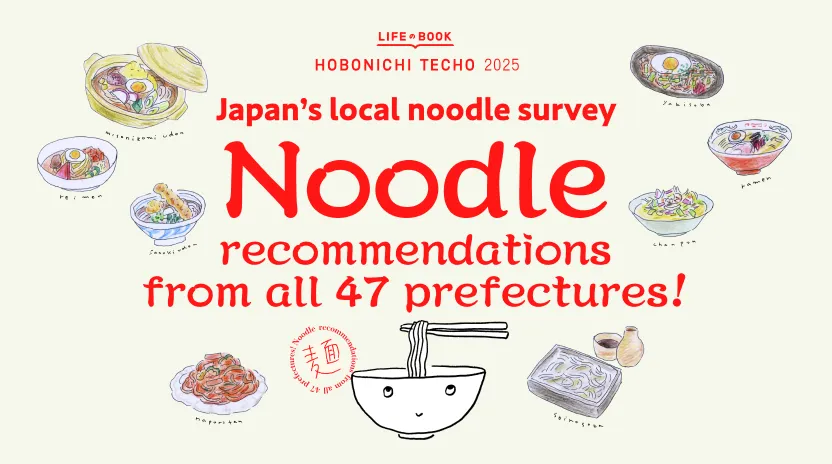Miyagi

Recommended noodles from the 47 prefectures
Miyagi Prefecture
We received a lot of comments about:
- Shiroishi Umen
- Mabo-Yakisoba
Share
2024-11-06
Illustration: Aya Ishimatsu (Shimarisu Design Center)

Miyagi Prefecture
We received a lot of comments about:
2024-11-06
Illustration: Aya Ishimatsu (Shimarisu Design Center)
Shiroishi Umen
It is the specialty noodle of Shiroishi in southern Miyagi. It is similar to somen but healthier for the stomach since they don’t use any oil when producing. Once upon a time (probably in the Edo period), there was a son who was worried about his father, who had a sensitive stomach, was eating little, and was growing weaker. The son learned from a traveling Buddhist monk how to make noodles without oil; he produced them and had his father eat them, saving the father’s life. The lord (who is said to be Kojuro Katakura), who was pleased with the kindness of the son, named the noodles “Umen” warm noodles. I often ate these noodles because I come from Shiroishi, and my mother worked part-time at a Umen noodle factory. We would eat them in different styles depending on the season, sometimes warm with starchy sauce and sometimes cold. It is quick and easy to boil since the noodle length is half of regular somen noodles. Now that my mother has retired from her part-time job, I no longer receive a box of these noodles, but I often stop by outlets selling foods and products of Miyagi to get some. Warm umen noodles are what I feel like eating this time of the year.
(Kitaoka Risa)
I recommend it because of its extremely short nine centimeters length, the rarity of being found only in Shiroishi, Miyagi, the stoicism of producing it with flour, water, and salt and without oil, and the uniqueness of requiring only two to three minutes of boiling time despite the history of more than 400 years. The eating style resembles somen’s, but umen is a must for okuzukake, a local Miyagi dish. It is such a local food that you probably cannot find any umen-serving restaurants outside Shiraishi.
(Ichiho)
I am from northern Miyagi, which is different from Shiroishi. However, I often had umen in okuzukake at Buddhist memorial services, during the higan period, or when I caught a cold. Okuzukake is a local dish of umen served in a thickened soy sauce broth with vegetables, chicken, fried tofu, and other ingredients. The word “kuzu” in okuzukake comes from the fact that it was thickened with kuzu arrowroot starch, but nowadays, most people use potato starch. Umen are short dried noodles of about ten centimeters produced without oil; a bunch of these is enough for one person. It looks similar to somen. They are short, cute noodles that boil up quickly and are just the right amount for one person. Although I sometimes eat it like pasta topped with store-bought pasta sauce, my favorite is to have it as okuzukake. Eating okuzukake reminds me of my grandparents and other older family members who passed away.
(EMMA)
Umen is similar but quite different from somen. Unlike somen, umen are healthy noodles since they are produced without oil. Their short length makes them easy to boil and eat! You can enjoy them warm or cold, just like somen. They are must-haves for Saturday lunches!
(Mogu)
I often had umen since I am from Shiraishi. In the summer, we would enjoy them like somen, cold with soy sauce dipping sauce, and in winter, we would eat them like udon or soba noodles, dipped in warm sauce with vegetables such as deep-fried tofu and radish. You can also find restaurants in Shiraishi that serve umen and enjoy them with sesame sauce or walnut sauce. They are also delicious with tempura. Since they are sold as dried noodles, you can keep them for a long time.
(Miyasan)
Mabo-Yakisoba
It is the cheap but tasty local food of Sendai. My favorite is the Mabo-Yakisoba at “Mammi.” It is delicious to have the thick, starchy sauce clinging to the yakisoba with a roasting aroma.
(Kou)
I recommend the “Hoen” restaurant. It serves baked Chinese noodles topped with bean-curd soup. The noodles’ moderate spiciness and savory flavor make it a delicious dish that will keep you coming back again and again!
(Yukinko)
The fried noodles with bean-curd soup on top are surprisingly tasty and not too oily. The “Ryutei” Chinese restaurant in Sendai was delicious.
(Shiu)
Hiyashi-Chuka
It is said to originate in Sendai! I had my first dish in elementary school at a Chinese restaurant in the Sendai Hotel (which is no longer in business, and the building is no longer there). The Hiyashi-Chuka chilled Chinese noodles at the ramen restaurant in the Sendai Station building are also delicious! I prefer to have it dissolve a lot of mustard in the sauce!
(Tonbo daisuki)
I had it on a business trip and found it incredibly delicious. I heard that it originated in Sendai. I want to go back and eat it again.
(Maasuke)
Nori-Udon
The Nori-Udon at “Chanko Haginoi” is also recommended by the super-famous comedy duo Sandwich-Man. Nori seaweed is kneaded into the noodles, giving them an aroma reminiscent of the sea.
(Kimuchi)
Miyagi
Shiroishi Umen